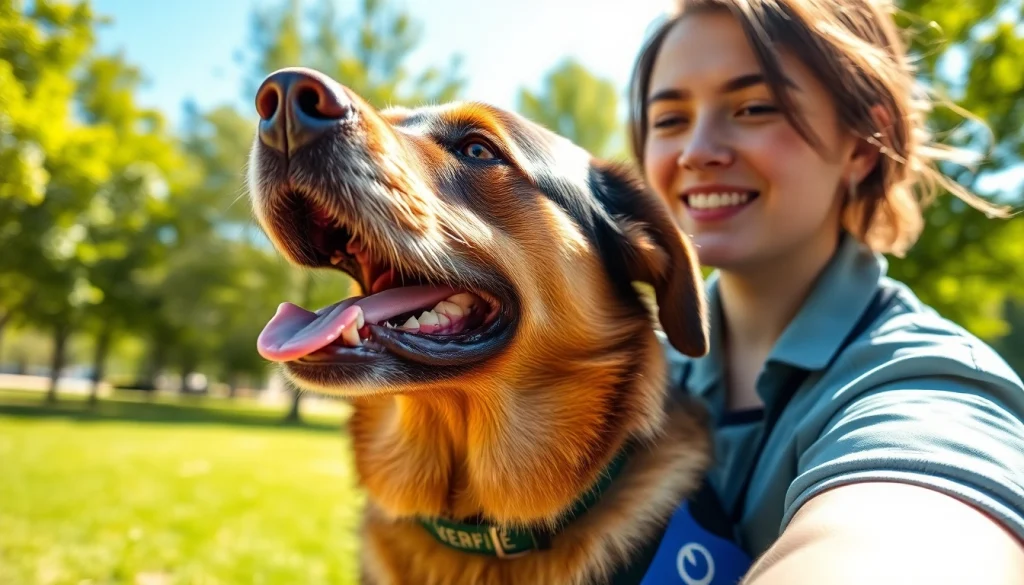Understanding Service Dogs
What is a Service Dog?
Service dogs are specially trained animals that assist individuals with disabilities by performing specific tasks to enhance their quality of life. Unlike emotional support animals or therapy dogs, service dogs are recognized by law and are granted specific rights to accompany their handlers in various public settings. These dogs undergo rigorous training from accredited organizations to learn skills that directly mitigate the handler’s disability. This ensures they are well-equipped to provide necessary support in daily situations.
Types of Service Dogs and Their Roles
Service dogs can be categorized into several types based on the specific needs they address. Here are some common types:
- Guide Dogs: Assist individuals who are visually impaired or blind, helping them navigate their environment safely.
- Hearing Dogs: Alert individuals with hearing impairments to important sounds, such as doorbells or alarms.
- Mobility Assistance Dogs: Aid individuals with physical disabilities by retrieving items, opening doors, or providing stability while walking.
- Medical Alert Dogs: Trained to recognize medical conditions, such as diabetes or seizures, and notify their handlers of impending episodes.
- Psychiatric Service Dogs: Assist individuals with mental health disorders, such as PTSD or severe anxiety, by performing tasks that mitigate their symptoms.
Each type of service dog serves a unique purpose, highlighting the importance of having the right dog for an individual’s specific needs.
Benefits of Having a Service Dog
The advantages of having a service dog are substantial and multifaceted. Some key benefits include:
- Increased Independence: Service dogs enable individuals to perform daily tasks that would otherwise be difficult, promoting a sense of autonomy.
- Companionship: Beyond their functional assistance, service dogs offer emotional support and companionship, which can reduce feelings of loneliness and isolation.
- Enhanced Safety: Service dogs can alert their handlers to potential dangers or assist in emergencies, providing an added layer of safety.
- Improved Mental Health: The presence of a service dog can alleviate anxiety and depression symptoms, contributing to overall mental well-being.
In essence, service dogs can transform the lives of individuals with disabilities, providing them the tools they need to navigate their world more effectively.
Eligibility Criteria to Get a Service Dog
Common Disabilities That Qualify
To qualify for a service dog, individuals must typically have a documented disability. Common qualifying conditions include:
- Visual Impairments: Such as blindness or significant loss of vision.
- Hearing Impairments: Including deafness or partial hearing loss.
- Mobility Impairments: Conditions that affect a person’s ability to walk, stand, or maintain balance.
- Seizure Disorders: Disorders that cause seizures, requiring immediate assistance during episodes.
- Mental Health Conditions: Such as PTSD, severe anxiety disorders, or depression requiring supportive tasks from a service dog.
It’s important to note that each service dog organization may have its own criteria regarding what constitutes a qualifying disability.
Medical Documentation Requirements
When seeking to get a service dog, obtaining thorough medical documentation is essential. This documentation typically includes:
- A letter from a licensed healthcare provider detailing the individual’s disability and how a service dog would assist.
- Any previous medical records that may support the case for acquiring a service dog.
- Documentation of the specific tasks the dog will need to perform to assist with the disability.
Having well-structured documentation can play a pivotal role in the approval process for a service dog application.
Understanding the Application Process
The process of obtaining a service dog involves several critical steps:
- Research: Investigate various accredited organizations that provide service dogs to find one that fits your specific needs.
- Application: Complete an application form detailing your disability and need for a service dog.
- Interview: Attend an interview with the organization to discuss your specific needs and how a service dog could assist.
- Training: If approved, you may need to undergo training with your new service dog to establish a bond and ensure the dog can perform required tasks effectively.
- Follow-up: Organizations may require periodic check-ins to assess the progress and health of the service dog and handler.
Understanding each step can help potential candidates navigate the process more smoothly.
How to Get a Service Dog: Resources and Training
Finding Accredited Training Programs
One of the most critical aspects of getting a service dog is identifying an organization that offers accredited training programs. Consider looking for programs affiliated with recognized bodies such as Assistance Dogs International or similar accrediting organizations. These programs follow strict guidelines to ensure that service dogs provide optimum assistance.
Research credible reviews and testimonials to gauge the effectiveness of the training programs, and ensure they cover the specific tasks relevant to your disability.
Cost Considerations and Financial Aid
The costs associated with obtaining a service dog can be significant, encompassing training fees, medical coverage, and ongoing care. While prices may vary, some organizations may offer financial assistance or sliding scale fees based on income. Here are some options for financial aid:
- Grants: Various non-profit organizations and charities provide grants that can help offset the cost of service dogs.
- Fundraising: Many individuals and families have successfully raised funds through social media campaigns or community events.
- Insurance Coverage: Some health insurance policies may cover service dog expenses; it’s advisable to check with individual insurance providers.
Careful planning and exploration of these options can significantly ease the financial burden of acquiring a service dog.
Volunteer and Community Programs for Assistance
Local community organizations often present valuable resources for individuals seeking to get a service dog. Many volunteer programs provide free training or assistance in pairing individuals with service dogs. Networking within local disability or veterans’ groups can also uncover opportunities and resources that may not be widely advertised.
Engaging directly with community groups can facilitate the process, providing both emotional support and practical assistance in locating and training the right service dog.
Legal Rights and Responsibilities of Service Dog Handlers
Understanding the ADA and Service Dog Regulations
The Americans with Disabilities Act (ADA) outlines the federal definition of service animals and provides essential legal protections for handlers. According to the ADA:
- Service dogs are permitted in all areas where the public is allowed to go.
- Businesses and other entities cannot require documentation, such as proof of training or certification, until service dogs are specifically trained to assist with the handler’s disability.
- Handlers cannot be charged extra fees for having a service dog accompanying them.
Understanding these legal rights can empower handlers to advocate effectively for themselves and ensure they are treated with respect in public spaces.
Handler Rights in Public Spaces
Handlers of service dogs are granted certain rights when accessing public spaces. These include:
- Access to Public Areas: Service dogs must be allowed in all public places, including restaurants, stores, and public transportation.
- Exemption from Pet Policies: Businesses cannot impose pet policies that exclude service dogs.
- Privacy Protections: Handlers are not required to disclose their disability or provide any detailed information about their service dog’s training.
Recognizing and standing firm on these rights can help handlers navigate encounters with business owners or others who may not be familiar with ADA regulations.
Responsibilities of the Handler
With the rights granted to service dog handlers come specific responsibilities. These include:
- Control of the Dog: Handlers must maintain control of their service dogs at all times, either through a harness or leash.
- Cleaning Up: Handlers are responsible for cleaning up after their service dogs, just as pet owners must do.
- Training and Health: Regular training and healthcare must be ensured for the service dog to maintain its efficacy and performance.
By fulfilling these responsibilities, handlers can foster a positive perception of service dogs in the community and ensure smoother interactions in public.
Living with a Service Dog: Tips for Success
Training Your Service Dog for Daily Tasks
Successful integration of a service dog into daily life requires ongoing training and reinforcement of learned tasks. Here are some tips:
- Consistency: Regular training sessions should be consistent, utilizing the same commands and rewards to encourage positive behavior.
- Real-World Practice: Taking your service dog to different environments will help reinforce training and ensure adaptability.
- Collaborative Training: Involve family and friends in training activities to ensure that the dog responds to commands from various individuals.
By fostering a strong training regimen, handlers enhance the effectiveness of their service dogs in day-to-day scenarios.
Establishing a Support System
Living with a service dog can bring unique challenges. Establishing a solid support system is vital for both the handler and the dog. This can include:
- Networking with Other Handlers: Connecting with other service dog handlers can provide an invaluable support system and share insights and experiences.
- Regular Veterinary Care: Establish a relationship with a vet who understands service dogs’ unique needs and can provide comprehensive healthcare solutions.
- Community Support Groups: Joining support groups can provide resources and emotional backing for the handler’s journey.
These supportive frameworks not only aid in managing challenges but enhance the overall experience of having a service dog.
Maintaining the Health and Well-being of Your Service Dog
The well-being of a service dog is paramount to ensure that they can effectively assist their handler. Key aspects of maintaining health and wellness include:
- Regular Exercise: Ensuring the dog has adequate physical activity to maintain its health and energy levels.
- Balanced Diet: Feeding a nutritious diet designed for the specific breed and health needs to promote longevity and vitality.
- Routine Veterinary Visits: Regular check-ups and vaccinations are crucial to sustain a service dog’s health.
Taking proactive steps in health management not only benefits the dog but ensures the handler receives the support they need from their companion.





